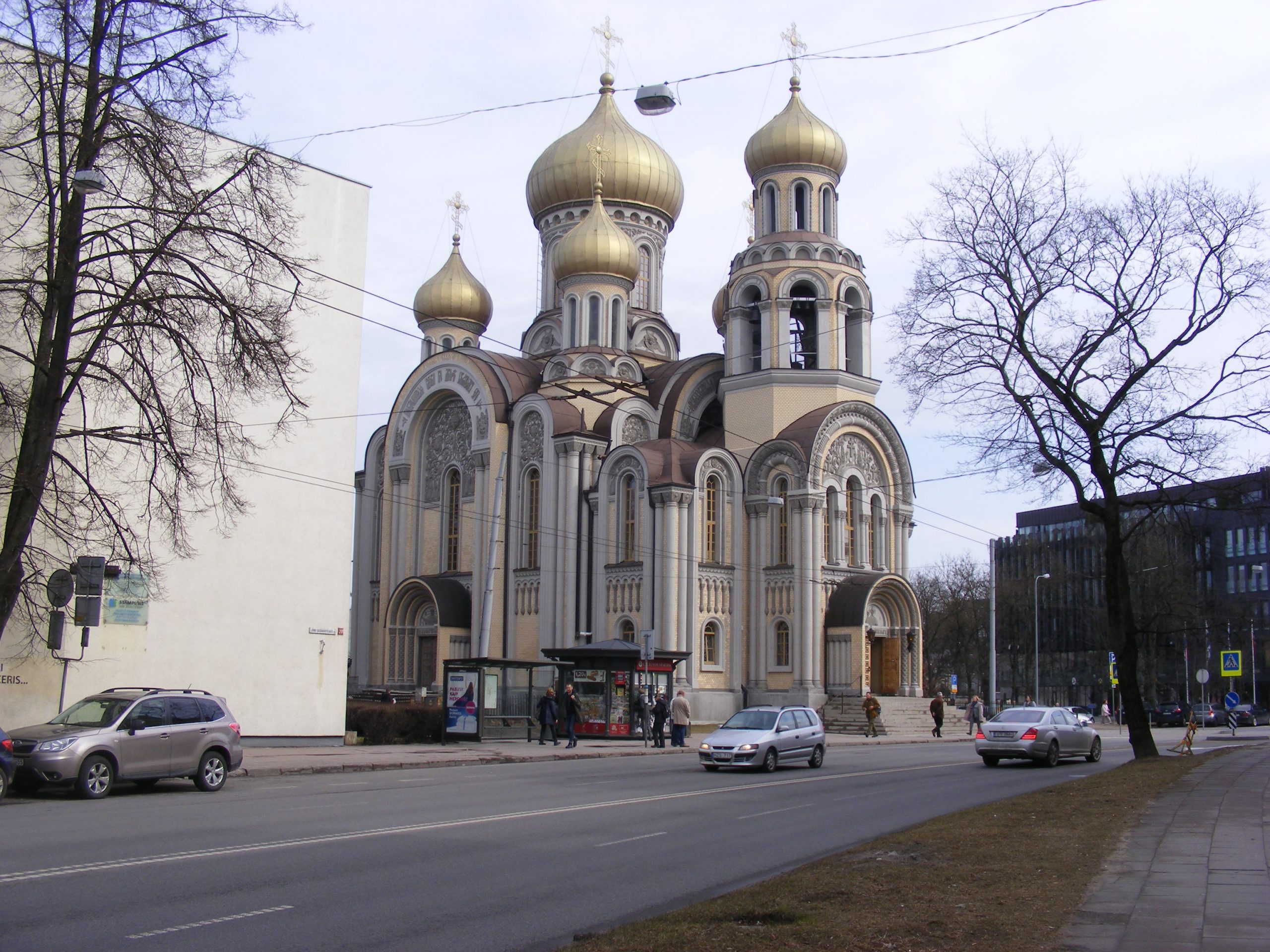Views: 1065
 It is one of the most attractive Russian Orthodox churches in Vilnius: the exterior is a profusion of shining onion-shape domes; but the interior is remarkably serene. The interior’s simplicity is interupted only by an elaborate iconostasis
It is one of the most attractive Russian Orthodox churches in Vilnius: the exterior is a profusion of shining onion-shape domes; but the interior is remarkably serene. The interior’s simplicity is interupted only by an elaborate iconostasis
 The internal space is created by two huge pairs of parallel semi-circular arches, intersecting at the top under the central dome which is also the main source of light
The internal space is created by two huge pairs of parallel semi-circular arches, intersecting at the top under the central dome which is also the main source of light
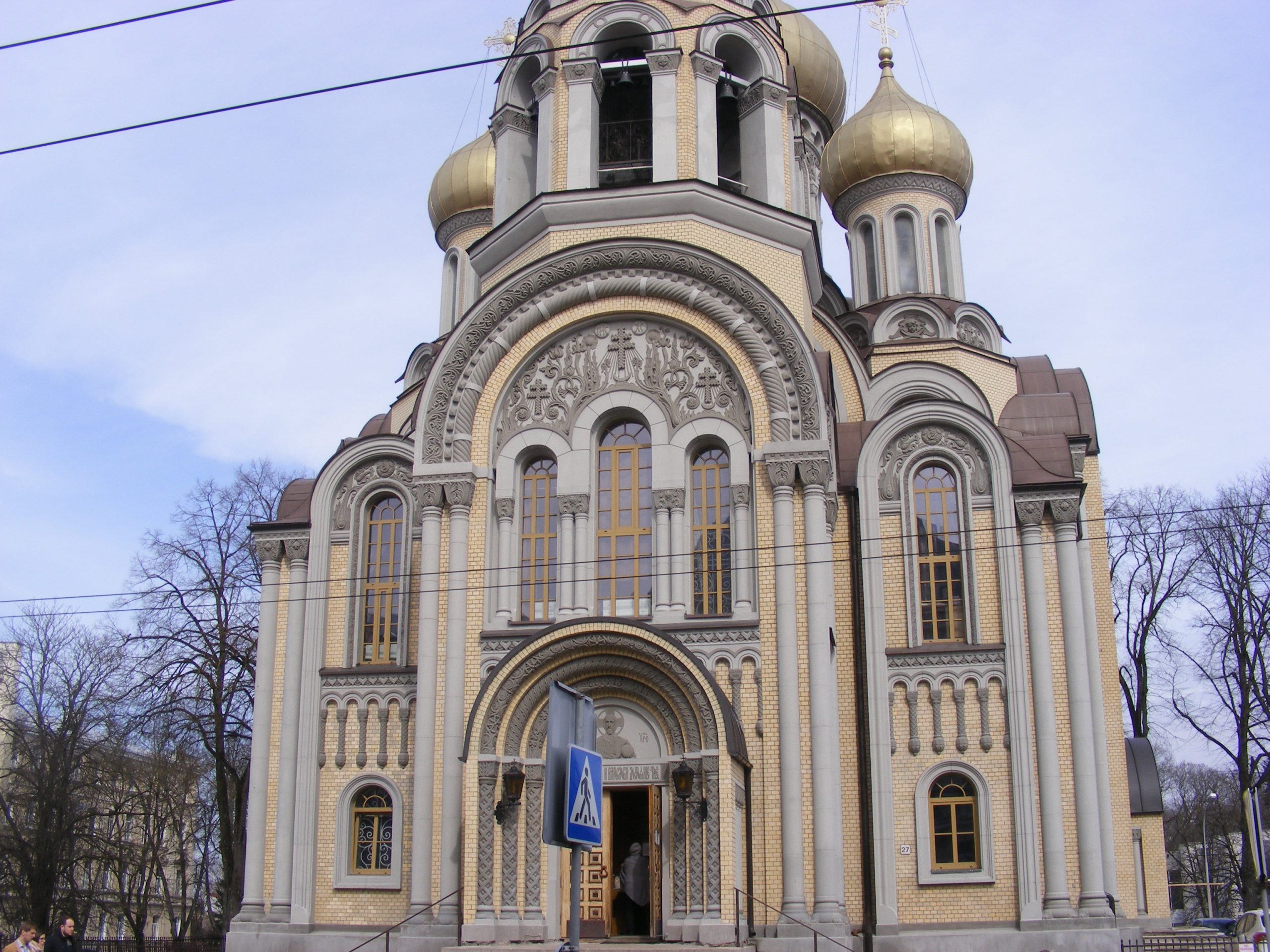 A panel on the right of the iconostatis depicts the two saints, both from noble families in the Middle Ages, to whom the church is dedicated
A panel on the right of the iconostatis depicts the two saints, both from noble families in the Middle Ages, to whom the church is dedicated
All photos are copyrighted by Vladislav B. Sotirovic
© Vladislav B. Sotirovic 2020
RELATED POSTS
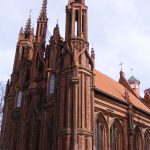
Church of St. Anne (left) and Bernardine Church (right). The church of St. Anne is a unique monument of red firebrick Gothic architecture in LithuaniaSt. Anne Church, designed in 1495-1500 by Benedikt Rejt, built up at the turn of the 15th century, and renovated in 1902-1909. 35 different kinds of brick were used help in creating the church. The façade was reinforced in 1960-1970St. Anne Church - a church which French Emperor Napoleon Bonaparte wanted to put on his palm and carry it over to Paris. The Church of St. Anne is symmetrical, marked by graceful, pointed forms that continue upwardAll photos are copyrighted by Vladislav B. Sotirovic© Vladislav B. Sotirovic 2018
Continue Reading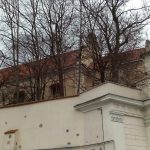
The church was originally Gothic but in 1750-1755 it was restored according to design by Franz Ignatius Hoffer and acquired some late Baroque and Rococo featuresNearby the church building stand the 17th-18th-century buildings of the Carmelite Monastery which had a rich archive and library. A study centre opereted there. In 1797-1944 it housed the Ecclesiastical Seminary Today the buildings are used by the Centre for Book Research and Libraries, and the church is closed to the publicAll photos are copyrighted by Vladislav B. Sotirovic© Vladislav B. Sotirovic 2020
Continue Reading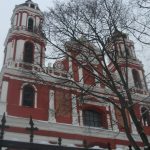
The church was built on the north side of the Lukiškių Square in 1624. However, the present building dates from the late 17th-18th cent.It is a single-nave Baroque church with cylindrical vaults. An image of the miraculous painting of the 18th century high altar occupies the niche above the porticoThe niches hold wooden 18th cent. statues of St. Hyacinth and St. Dominic. During the Soviet times there were designs to demolish the church but it did not ever happenAll photos are copyrighted by Vladislav B. Sotirovic© Vladislav B. Sotirovic 2018
Continue Reading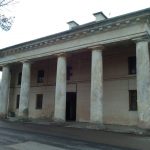
In 1780, Vilnius Bishop Ignacy Massalski settled in Verkiai. He commissioned Lithuanian architect Laurynas Gucevičius to reconstruct an earlier palace. The general plan and maintenance buildings were designed by Lithuanian architect Martin KnackfussThe ensemble encompasses the park of 36 ha. Situated on two terraces, the park consisted of two parts - the upper and the great park. A view of Vilnius and the Neris River is exposed from a steep slopeSince 1960 the ensemble belongs to the Lithuanian Academy of Science and is gradually renovatedAll photos are copyrighted by Vladislav B. Sotirovic© Vladislav B. Sotirovic 2021
Continue Reading
Wonderful panoramic view can be seen from the roof (platform) of Gediminas Tower (Upper Castle Tower)Despite wars and destructions, the architectural ensemble of Vilnius Old Town remains unique. Baroque domes and towers of Vilnius Old Town coexist with an irregular medieval city plan Vilnius Old Town is lacking German or Scandinavian features, rather reminiscent of Prague or Rome, Vilnius differs greatly from the other Baltic capitalsAll photos are copyrighted by Vladislav B. Sotirovic© Vladislav B. Sotirovic 2019
Continue Reading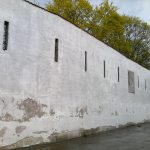
It was not until 1503 when Grand Duke of Lithuania and King of Poland Alexander Jagiellon granted a privilege that the construction of the wall began. The year 1522 is considered to mark the end of the construction, when Grand Duke of Lithuania Sigismund the Old exempted the residents of Vilnius from the duty of keeping guard at the castle and ordered 24 guards to be posted at the city gatesThe length of the defensive wall was 2,5 kilometres having 10 gates. The wall surrounded the territory of today's Old Town, approximatelly 100 hectars. The foundation of the defensive wall was built of stone, and bricks were mainly used at the level of loopholes and higher. The was was adapted for defence with gunpoweder-operated firearms Until the late-18th century, the Vilnius defensive wall was frequently renovated. The wall served for the last time in 1794 during the uprising led by ...
Continue Reading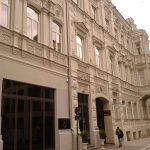
The building in Vilnius Street in Vilnius No. 25 in which Jonas Basanavičius died in hospital on February 16th, 1927. The day of his death coincided with the anniversary of the Independence Act in 1918A memorial plaque on the building informs that in this building in 1909 the Editorial Board of the oldest Lithuanian newspaper "Lithuanian News" started to work Another memorial plague on the building as this building housed a music school, where the famous violinist Jascha Heifetz studied in 1905-1909 All photos are copyrighted by Vladislav B. Sotirovic© Vladislav B. Sotirovic 2022
Continue Reading
Christmas Tree decoration at the Cathedral Basilica Square in Vilnius. The belfry is seen in the backgroundChristmas decoration in front of the principal building of the castle complex in Vilnius Old Town - Cathedral BasilicaCathedral Basilica of Vilnius is erected on the place of the pagan altar with a ceasred fire to the pagan god Perkūnas (god of Thunder)All photos are copyrighted by Vladislav B. Sotirovic© Vladislav B. Sotirovic 2019
Continue Reading
The church is inconspicuous from the street, as its façade does not face the streetThe 51 meter-tall dome can be seen from seven Old Town streetsThe Dominican Church of the Holy Spirit is one of the most magnificent churches in Vilnius. It is an excellent monument of high and late Baroque All photos are copyrighted by Vladislav B. Sotirovic© Vladislav B. Sotirovic 2018
Continue Reading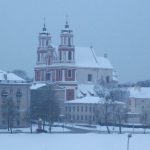
The present church was built in the late 17th century, after its predecessor was burnt down in the 1655 during the war with Russia. The church was completed only in the middle of the 18th century The nave is 24 metres high, making it the tallest in Vilnius; and its length is the same, with accounts for its concentrated appearance when viewed from the sideIn the north tower is a particularly ornate chapel, dedicated to the Dominican St. Hyacinth, with frescoes depicting scenes from his life. The fresco above the entrance depicts the Virgin Mary and Angels. The church was returned to the Dominicans in 1993All photos are copyrighted by Vladislav B. Sotirovic© Vladislav B. Sotirovic 2018
Continue Reading
Martynas Mažvydas National Library of Lithuania is a national cultural institution open to all users, active in the areas of dissemination of information, culture, science, and education, performing library activities and ensuring implementation of the national information policy falling within its competence The mission of the library is to be the Lithuanian space of knowledge-creating value for the public The vision of the library: to become an integral part of the state's information policy, culture, education, science, and economic progressAll photos are copyrighted by Vladislav B. Sotirovic© Vladislav B. Sotirovic 2019
Continue Reading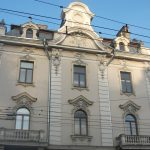
Beside the main house (close to the Antakalnio St.) stands a residential house, in which the first exhibition of Lithuanian art took place in 1907A monument to the brothers Vileišis in Vilnius near the River NerisThe main Vileišis building was one of the first in Vilnius, for whose construction a rare material in Lithuania - concrete - was used. The main house was built in 1904-1906 by the Lithuanian businessman and public figure Petras Vileišis according to a design by engineer August Klein All photos are copyrighted by Vladislav B. Sotirovic© Vladislav B. Sotirovic 2018
Continue Reading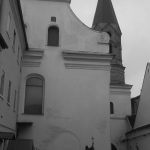
This is the first Evangelical Lutheran Church (Kirche) built-in Vilnius in 1555 on the initiative of the Chancellor of the Grand Duchy of Lithuania Nicholas Radziwiłł the Black. In front of the church, there is a monument erected to Martin Luther The church was rebuilt in 1662 and substantially reconstructed in 1738-1744. In 1944 it was closed down. In 1993 it was returned to the parishioners and renovatedThe church has a single nave and an original pentagonal shape. Its magnificent high altar was designed by German Protestant architect Jan (Johan) Krzysztof GlaubitzAll photos are copyrighted by Vladislav B. Sotirovic© Vladislav B. Sotirovic 2019
Continue Reading
Town Hall Square has been a market place since very early times, and it today dominated by the Town Hall which was formerly a court, with the basement being used as prison cellsThe Town Hall back-side. The present building was constructed between 1785 and 1799 by the Classical architect Lithuanian Laurynas Stuoka-Gucevičius The square in front of the Town Hall is the venue for an annual three-day crafts market on the weekend closest to March 4th, St. Casimir's DayAll photos are copyrighted by Vladislav B. Sotirovic© Vladislav B. Sotirovic 2020
Continue Reading
The interior sculptural décor was created by Pietro Perti (Italian master) in 1700-1705. Twin towers were built on in the 18th century. It was built by the efforts of Casimir Sapieha the Younger (1637-1720) in 1694-1717 On the façade frieze two Christian soldiers taken into captivity by the Muslims are represented. The main goal of the Trinitarian Order was returning such captives to their homelands The church has an impressive cupola (dome), the interior is adorned with stucco relief works and sculptures - a large part of them is survived. The church is a "sister" to the Church of St. Peter and St Paul in Vilnius (Antakalnis)All photos are copyrighted by Vladislav B. Sotirovic© Vladislav B. Sotirovic 2019
Continue Reading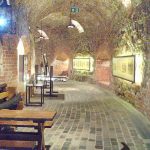
A semi-circular corridor of the Bastion of Vilnius, where cannons were lined up at embrasures, was called a casemate. A special platform with a parapet for heavy artillery was built on the terrace of the bastionA 48-m long, 2,8-m wide and 3,5 m high impressive tunnel leads from the tower to the underground casemate. Cannons brought to the tower would be rolled down this tunnelThe main part of the Bastion of Vilnius is the casemate. It is an underground horseshoe-shaped room for cannons. The casemate forms a semicircle around a 3-4 metre-high hill heightened with sand. From the outside the façade is 8 m high, and sloping, and is built from bricksAll photos are copyrighted by Vladislav B. Sotirovic© Vladislav B. Sotirovic 2020
Continue Reading
Tour № 1 – Šventaragis ValleyCathedral Basilica of St. Stanislaus & St. VladislausCathedral Basilica of St. Stanislaus & St. Vladislaus (inside, including the Chapel of St. Casimir, the Chapel of Deportees, the Gasztołd Chapel, the Royal Chapel, St. Wladislaw/Vladislaus/Ladislav Chapel, High alter, Memorial plague to the Grand Duke of Lithuania Vytautas Magnus, the Sapieha Madona’s picture, etc)Cathedral Basilica Bell TowerRoyal Palace of Lithuania (the Palace of Grand Dukes of the Grand Duchy of Lithuania)Upper CastleUpper Castle’s West (Gediminas) TowerOld Arsenal – Museum of Applied ArtNew Arsenal – Lithuanian National MuseumMonument to King Mindaugas (1236-1263: Crowned King on July 6th, 1253)Monument to Lithuanian Grand Duke Gediminas (1316-1341: the founder of Gediminian-Jagiellonian ruling dynasty)Tour № 2 – Vilnius University & Monastery QuarterVilnius University – Historical Campus (est. 1579)Vilnius University – the Bronze door of the Central LibraryVilnius University – Historical Campus (inside, including 12 university’s courtyards, Domus Philologiae, Smuglevičius Hall, White (Observatory) ...
Continue Reading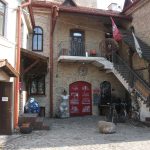
Užupio street is the main street in the city's district of Užupis. The district was in the Soviet time one of the most dilapidated districts in Vilnius. Many of the buildings did not have electricity and sanitary facilities, and the streets were unlitThe River Užupis which separates Užupis district from the Old Town. On one side of the river is a unique ensemble of sacred buildings and a park, while on the other side is "Republic of Užupis", where a number of artists live and work"Angel of Užupis" sculpture. An angel is playing a trumpet that provides ideas about Užupis to others and protects the district. The 24th Article of the Constitution of Užupis, for instance, says that "Everyone has the right to understand nothing". The district is separated from the Old Town by the River Vilnia on three sides, and by a high hill on the fourth sideAll photos ...
Continue Reading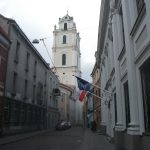
In this street, it was used to be a market place where it meets Pilies street. The first Town Hall is also believed to have stood on this spot Pharmacy house in St. John St. No. 5. Georg Schulz's pharmacy operated in this house since 1639. During the war in 1655, the house was burned down. In 1781, pharmacist Koszyk acquired the ruined building and reconstructed it The Pac estate. Since 1628, the building belonged to the Pac magnate family of the Grand Duchy of Lithuania. In 1783, the dilapidated building was bought, renovated and decorated by the Chancellor of the Grand Duchy of Lithuania - Alexander Michael Sapieha. Currently, the building belongs to the Polish Embassy All photos are copyrighted by Vladislav B. Sotirovic© Vladislav B. Sotirovic 2020
Continue Reading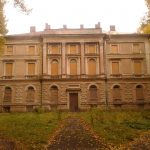
The historical building in Tyzenhauzų Str. in VilniusTyzenhauzų Str. building in VilniusTyzenhauzų Str. building in VilniusAll photos are copyrighted by Vladislav B. Sotirovic© Vladislav B. Sotirovic 2021
Continue ReadingChurch of St. Anne
The Church of St. George the Martyr
Church of St. Jacob and Philip (1)
The Ensemble of the Verkiai Estate
Vilnius Old Town Panoramic View
The Defensive Wall of Vilnius
The Building in Vilnius Street No. 25
Vilnius Christmas Tree
Church of the Holy Spirit & Former Dominican Monastery (Exterior)
Church of St. Jacob and Philip (2)
National Martynas Mažvydas Library
Vileišis Estate
Evangelical Lutheran Church
Around Town Hall Square in Vilnius
Church of Our Lord Jesus and the Trinitarian Monastery
The Bastion of the Vilnius Defensive Wall (III)
Vilnius – Guided Sightseeing Tours
“Republic of Užupis”
St. John Steet in Vilnius
Tyzenhauzų Str. building in Vilnius

